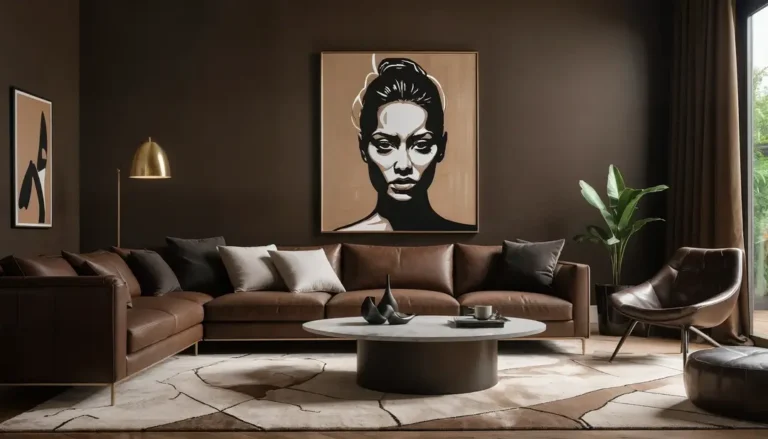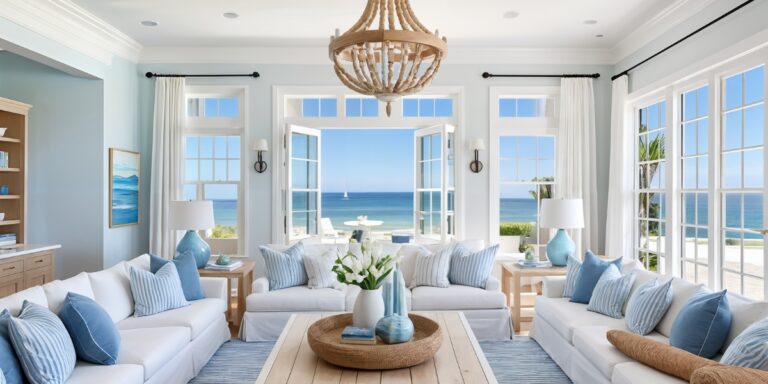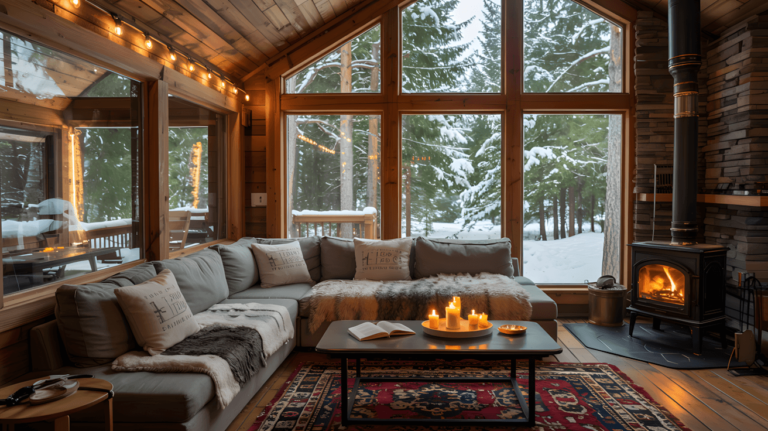In my years of helping homeowners create beautiful and functional living spaces, I’ve observed that grey and beige combinations offer something particularly appealing—the ability to create environments that feel both sophisticated and genuinely comfortable for everyday family use.
The challenge lies in implementing these neutral tones effectively so they enhance rather than flatten a space, creating visual interest while maintaining the serene foundation that draws many people to these colors.
Through various neutral living room projects, I’ve learned that successful grey and beige implementation depends on understanding how these colors work together while considering practical factors like natural light availability, room size, and daily functionality requirements.
I’ve seen expensive neutral renovations that felt bland because they lacked sufficient texture or contrast, and I’ve learned to prioritize approaches that create depth and warmth while maintaining sophisticated appeal.
These 25 grey and beige living room ideas represent approaches I’ve found effective in creating spaces that balance elegance with livability, each offering solutions for different architectural contexts, lighting conditions, and lifestyle needs.
Note: For any structural modifications, electrical work, or installations mentioned in this article, always consult with licensed professionals to ensure safety and code compliance.
1. Modern Minimalist Foundation

This approach emphasizes clean lines and uncluttered aesthetics using neutral foundations. Soft grey sofas with simple beige rugs can create serene environments while allowing natural light to enhance spatial openness.
Geometric furniture and carefully selected statement pieces can provide visual interest without overwhelming the minimalist principles. The combination typically works well in spaces with good natural light and modern architectural features.
Minimalist considerations: Successful minimalist designs often require high-quality pieces and excellent proportions since each element becomes more visually prominent.
2. Comfort-Focused Texture Strategy

This approach prioritizes tactile comfort through layered textiles and soft materials. Large sectional sofas with varied throw pillows and luxury blankets can create inviting environments for family relaxation.
Mood lighting and soft window treatments can enhance the cozy atmosphere while maintaining sophisticated color coordination. The combination often appeals to families wanting relaxation-focused spaces with elegant appeal.
Comfort materials: High-quality textiles often provide better durability and comfort in frequently used family spaces.
3. Rustic Material Integration

This approach incorporates natural materials for organic warmth within neutral color schemes. Light beige walls with grey fabrics can provide sophisticated foundations while reclaimed wood and natural fibers add character.
Wicker baskets and natural lighting can maintain the organic theme while providing practical storage and functionality. The combination typically works for those wanting sophisticated rusticity with modern comfort.
Natural material benefits: Authentic materials often age gracefully and provide lasting character within neutral color schemes.
4. Industrial Balance with Soft Elements

This approach combines raw architectural elements with soft neutral colors. Deep grey walls or exposed brick can provide dramatic backdrops while beige leather furniture adds comfort and warmth.
Steel fixtures and concrete elements can contribute contemporary edge while soft furnishings prevent spaces from feeling too harsh for daily living. The combination often appeals to those wanting urban sophistication with residential comfort.
Industrial softening: Raw materials in residential settings typically need balancing with comfortable textiles and warm lighting.
5. Scandinavian-Inspired Functionality

This approach uses Nordic design principles with neutral foundations. Light grey walls and beige furniture with natural wood elements can create airy, functional environments.
Natural lighting and simple storage solutions can enhance both aesthetics and daily practicality while maintaining the calm, organized feeling characteristic of Scandinavian design. The combination typically appeals to those wanting efficient living with sophisticated aesthetics.
Scandinavian principles: Nordic design often prioritizes functionality alongside beauty, making it practical for real family living.
6. Luxury Material Integration

This approach incorporates upscale materials for sophisticated elegance. Velvet and silk textures in grey and beige can provide luxury appeal while metallic accents add glamour.
Quality lighting fixtures and carefully chosen accessories can create elegant environments suitable for both daily use and entertaining. The combination often appeals to those wanting upscale aesthetics with neutral sophistication.
Luxury durability: High-end materials typically require specific care but provide lasting beauty and sophisticated appeal.
7. Soft Pastel Accent Strategy

This approach introduces gentle color through subtle accent elements. Soft pastels like blush pink or mint green can provide personality without overwhelming neutral foundations.
Easily changeable accessories allow for seasonal variation while maintaining neutral furniture investments. The combination typically works for those wanting gentle color interest within predominantly neutral schemes.
Pastel integration: Soft accent colors often work more successfully than bold ones in neutral-dominant rooms.
8. High-Contrast Drama Approach

This approach uses dramatic neutral contrasts for contemporary impact. Deep charcoal grey against light beige can create striking visual interest while remaining within neutral color families.
Dark wood or black accents can enhance the high-contrast effect while maintaining sophisticated color restraint. The combination often appeals to those wanting bold visual impact within neutral frameworks.
Contrast balance: High-contrast schemes require careful lighting and proportion planning to maintain functionality.
9. Mid-Century Modern Integration

This approach incorporates retro design elements with neutral foundations. Beige sectionals with grey accents can provide perfect backdrops for teak furniture and geometric patterns.
Statement lighting and vintage-inspired accessories can add character while maintaining contemporary functionality. The combination typically appeals to those wanting nostalgic character with modern comfort.
Mid-century coordination: Period-appropriate proportions and materials often work better than random vintage elements.
10. Zen-Inspired Serenity

This approach creates calm, meditative environments using neutral foundations. Soft muted greys and neutral beige can provide peaceful backgrounds for natural materials like bamboo and stone.
Minimal furniture arrangements and natural elements can promote relaxation while maintaining sophisticated appeal. The combination often works for those prioritizing stress reduction and peaceful living.
Zen principles: Successful meditation-inspired spaces often require restraint and natural material authenticity.
11. Monochromatic Grey Sophistication

This approach uses various grey tones for sophisticated depth. Different grey shades can create visual complexity while maintaining color unity and sophisticated appeal.
Tonal variations can provide spatial interest while preventing flat, monotonous appearances. The combination typically works in spaces with good natural light to showcase subtle color differences.
Monochromatic success: Single-color schemes often require excellent texture variation and lighting to prevent flatness.
12. Bohemian Texture Layering

This approach incorporates eclectic elements within neutral foundations. Grey and beige provide stable backgrounds for varied textures and patterns without visual competition.
Layered textiles and artistic accessories can add personality while maintaining overall design coherence. The combination often works for those wanting creative expression within sophisticated neutral frameworks.
Bohemian balance: Eclectic approaches require unifying elements like consistent color palettes to maintain visual harmony.
13. Traditional Elegance Integration

This approach incorporates classic design elements within neutral sophistication. Traditional furniture forms and patterns can work beautifully with grey and beige foundations.
Quality traditional materials and classic proportions can provide lasting appeal while maintaining comfortable, familiar aesthetics. The combination often appeals to those wanting timeless elegance with neutral sophistication.
Traditional materials: Classic elements often provide lasting value and sophisticated appeal within neutral color schemes.
14. Coastal-Inspired Tranquility

This approach incorporates beach-inspired elements for relaxing environments. Light beige walls with grey seating can provide calm foundations while whitewashed wood adds coastal character.
Ocean-inspired accessories and natural textures can enhance the nautical theme while maintaining sophisticated neutral appeal. The combination often works for those wanting vacation-like relaxation in daily living spaces.
Coastal authenticity: Beach-inspired elements work best when they complement rather than overwhelm neutral sophistication.
15. Urban Loft Sophistication

This approach incorporates metropolitan elements with neutral comfort. Dark grey walls or exposed architectural features can provide urban character while beige seating adds residential warmth.
Industrial elements and oversized windows can enhance the loft aesthetic while maintaining comfortable daily functionality. The combination often appeals to those wanting city sophistication with livable comfort.
Loft characteristics: Urban loft elements should serve functional purposes while contributing to the overall aesthetic.
16. Classic Neutral Refinement

This approach emphasizes timeless sophistication through quality materials and proportions. Grey upholstered furniture with beige accent pieces can create refined, lasting appeal.
Luxurious rugs and polished wood elements can enhance the elegant atmosphere while maintaining comfortable daily functionality. The combination typically provides enduring style that adapts to changing preferences.
Classic investment: Timeless design elements often provide better long-term satisfaction than trend-dependent choices.
17. Tropical-Inspired Calm

This approach incorporates island elements within neutral sophistication. Beige foundations with grey accents can provide calm backgrounds for tropical-inspired furniture and plants.
Natural materials like rattan and bamboo can add organic character while maintaining sophisticated neutral appeal. The combination often works for those wanting tropical relaxation with elegant restraint.
Tropical integration: Island-inspired elements work best when they enhance rather than overwhelm neutral sophistication.
18. Farmhouse Character Integration

This approach incorporates rural charm within neutral elegance. Rustic beige sofas with grey walls can provide comfortable foundations while vintage wooden elements add character.
Natural materials and vintage accessories can enhance the farmhouse theme while maintaining contemporary comfort and functionality. The combination appeals to those wanting nostalgic charm with modern livability.
Farmhouse authenticity: Rural-inspired elements should feel genuine rather than artificial for successful integration.
19. Tactile Texture Focus

This approach emphasizes varied textures for sensory richness. Different fabric textures—velvet, wool, cotton—can provide tactile appeal while maintaining neutral color harmony.
Layered rugs and varied cushion materials can create comfortable, inviting environments that encourage relaxation and comfort. The combination works well for those prioritizing physical comfort alongside visual appeal.
Texture variety: Multiple tactile elements can create rich, inviting environments within neutral color schemes.
20. Contemporary Sophistication

This approach combines modern elements with neutral elegance. Metallic accents and sleek lighting can provide contemporary edge while grey and beige maintain sophisticated foundations.
Abstract art and geometric patterns can add visual interest while maintaining clean, organized aesthetics. The combination typically appeals to those wanting current sophistication with lasting appeal.
Contemporary balance: Modern elements should enhance rather than overwhelm neutral sophistication for lasting appeal.
21. Open Minimalist Environment

This approach creates spacious, uncluttered environments using neutral foundations. Pale grey walls with simple beige furniture can provide serene backgrounds for carefully chosen statement pieces.
Clean lines and minimal accessories can enhance spatial openness while maintaining sophisticated appeal. The combination works well for those wanting calm, organized living with elegant restraint.
Minimalist space planning: Fewer elements require more attention to quality and proportion for successful results.
22. Glamorous Luxury Integration

This approach incorporates upscale elements for dramatic elegance. Velvet furniture and metallic accents can provide luxury appeal while maintaining neutral sophistication.
Statement lighting and luxurious textiles can create elegant environments suitable for entertaining while remaining comfortable for daily use. The combination appeals to those wanting glamorous sophistication with practical functionality.
Luxury balance: Glamorous elements should enhance daily comfort rather than compromising practical functionality.
23. Family-Focused Comfort

This approach prioritizes practical comfort for active family living. Durable sectional seating with easy-care fabrics can provide comfortable gathering spaces while maintaining elegant appeal.
Practical storage solutions and family-friendly materials can enhance daily functionality while preserving sophisticated aesthetics. The combination works well for families wanting elegance with real-world practicality.
Family durability: Furniture selections should consider actual family use patterns and maintenance capabilities.
24. Retro-Inspired Character

This approach incorporates vintage elements with neutral foundations. Mid-century furniture and retro accessories can add character while grey and beige provide sophisticated coordination.
Period-appropriate patterns and colors can enhance the vintage theme while maintaining contemporary comfort and functionality. The combination appeals to those wanting nostalgic character with modern livability.
Retro authenticity: Vintage elements work best when they represent genuine period characteristics rather than superficial styling.
25. Art Deco Sophistication

This approach incorporates geometric elegance with neutral luxury. Bold patterns and metallic accents can provide dramatic interest while grey and beige maintain sophisticated foundations.
Quality materials and dramatic lighting can create elegant environments with historical character while remaining comfortable for contemporary living. The combination appeals to those wanting dramatic sophistication with neutral restraint.
Art Deco integration: Period elements should enhance contemporary living rather than creating museum-like formality.
Creating Your Perfect Grey and Beige Living Room
Based on various homeowner experiences, successful grey and beige living room design often happens when you choose approaches that genuinely enhance your daily living patterns while providing the visual calm these colors offer.
Consider your actual room use—do you need spaces for active family gatherings, formal entertaining, or quiet relaxation?
The most functional neutral living rooms typically balance aesthetic sophistication with practical considerations like maintenance requirements, lighting conditions, and furniture durability for your specific lifestyle.
Start by honestly assessing your family’s daily needs, room lighting, and maintenance preferences, then consider which neutral approaches might enhance rather than complicate your enjoyment of the space.
Remember that neutral color schemes can serve as long-term foundations that adapt to changing preferences and life stages, so choosing quality materials and approaches that will age gracefully often provides better satisfaction than focusing solely on current trends.
Final reminder: Living room renovations may involve electrical work for lighting, structural modifications for built-ins, or other changes requiring professional consultation. Always ensure proper planning and code compliance for lasting safety and functionality.




